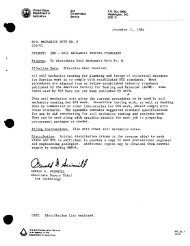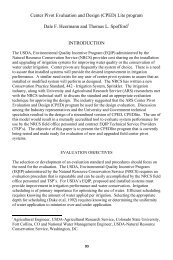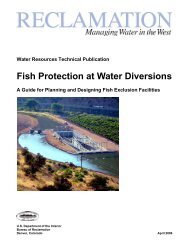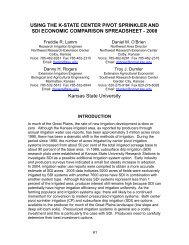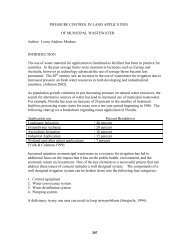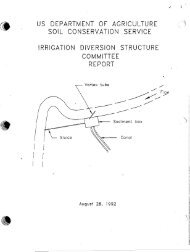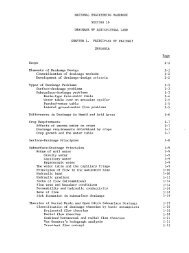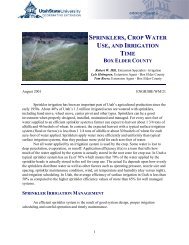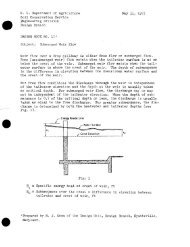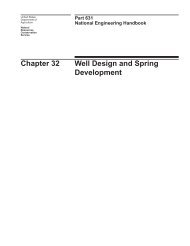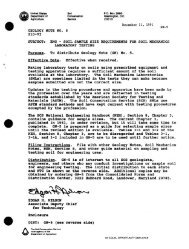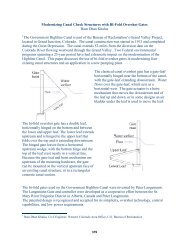Chapter 11: Sprinkle Irrigation - NRCS Irrigation ToolBox Home Page
Chapter 11: Sprinkle Irrigation - NRCS Irrigation ToolBox Home Page
Chapter 11: Sprinkle Irrigation - NRCS Irrigation ToolBox Home Page
Create successful ePaper yourself
Turn your PDF publications into a flip-book with our unique Google optimized e-Paper software.
Gun and boom sprinklers can be used on most<br />
crops, but they produce relatively high application<br />
rates and large water drops that tend to compact<br />
the soil surface and create runoff problems. Therefore,<br />
these sprinklers arc most suitable for coarsetextured<br />
soils with high infiltration rates and for<br />
relatively mature crops that need only supplemental<br />
irrigation. Gun and boom sprinklsrs are not recommended<br />
for use in extremely windy areas because<br />
their distribution patterns become too distorted.<br />
Large gun sprinklers are usually trailer or skid<br />
mounted and like boom sprinklers are towed from<br />
one position to another by a tractor. Boom sprinklers<br />
are unstable and can tip over when being<br />
towed over rolling or steep topography.<br />
Figure <strong>11</strong>-7,-Outer<br />
cnd of center-pivot lateral in operation.<br />
Contimous-Move Lateral<br />
Center-Pivot<br />
The center-pivot system sprinkles water f om a<br />
continuously moving lateral pipeline. The lateral is<br />
fixed at one end and rotates to irrigate a large<br />
circular area. The fixed end of the lateral, called the<br />
"pivot point," is connected to the water supply.<br />
The lateral consists of a series of spans ranging in<br />
length from 90 to 250 R and carried about 10 ft<br />
above the ground by "drive units," which consist of<br />
an "A-frame" supported on motor driven wheels<br />
(fig. <strong>11</strong>-7).<br />
Devices are installed at each drive unit to keep<br />
the lateral in a line between the pivot and end-drive<br />
unit; the end-drive unit is set to control the speed of<br />
rotation. The most common center-pivot lateral<br />
uses 6-in pipe, is a quarter mile long (1,320 ft), and<br />
irrigates the circular portion (126 acres plus 2 to 10<br />
acres more depending on the range of the end sprinklers)<br />
of a quarter section (I 60 acres). However,<br />
laterals as short as 220 ft and as long as a half mile<br />
are available.<br />
The moving lateral pipeline is fitted with impact,<br />
spinner, or spray-nozzle sprinklers to spread the water<br />
evenIy over the circular field. The area to be irrigated<br />
by each sprinkler set at a uniform sprinkler<br />
spacing along the lateral becomes progressively<br />
larger toward the moving end. Therefore, to provide<br />
uniform application the sprinklers must be designed<br />
to have progressively greater discharges, closer<br />
spacings, or both, toward the moving end. Typically,<br />
the application rate near the moving end is<br />
about 1.0 iph. This exceeds the intake rate of many<br />
soils except for the first few minutes at the beginning<br />
of each irrigation. To minimize surface<br />
ponding and runoff, the Iaterals are usually rotated<br />
every 10 to 72 hours depending on the soil's<br />
infiltration characteristics, the system's capacity,<br />
and the maximum desired soil moisture deficit.<br />
Five types of power units commonly used to drive<br />
the wheels on center pivots are electric motors,<br />
water pistons, water spinners and turbines, hydraulic<br />
oil motors, and air pistons. The first pivots<br />
were powered by water pistons; however, electric<br />
motors are most common today because of their<br />
speed, reliability, and ability to run backwards and<br />
forwards.<br />
Self-propelled, center-pivot sprinkler systems are<br />
suitable for almost all field crops but require fields<br />
free from any obstructions above ground such as<br />
telephone lines, electric power poles, buildings, and<br />
trees in the irrigated area. They are best adapted<br />
for use on soils having high intake rates, and on<br />
uniform topography. When used on soils with low<br />
intake rate and irregular topography, the resulting<br />
runoff causes erosion and puddles that may interfere<br />
with the uniform movement of the lateral<br />
around the pivot point. If these systems are used<br />
on square subdivisions, some means of irrigating<br />
the four corners must be provided, or other uses<br />
made of the area not irrigated. In a 160-acre quarter-section<br />
subdivision, about 30 acres are not irrigated<br />
by the centerpivot system unless the pivot is<br />
provided with a special corner irrigating apparatus,<br />
With some corner systems only about 8 acres are<br />
left rxnirrigated.<br />
Most pivot systems are permamently installed in<br />
a given field. But in supplemental irrigation areas



